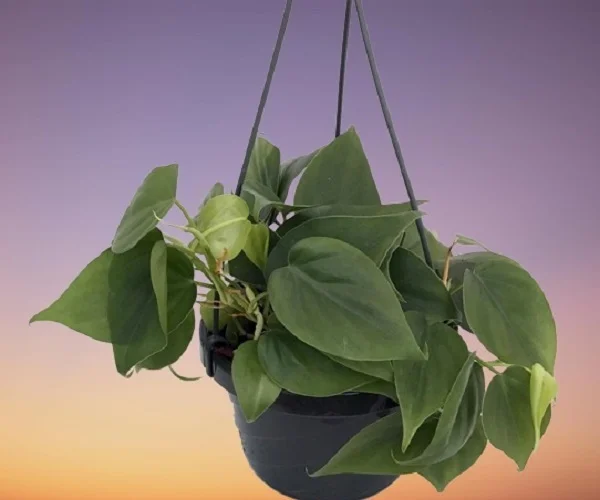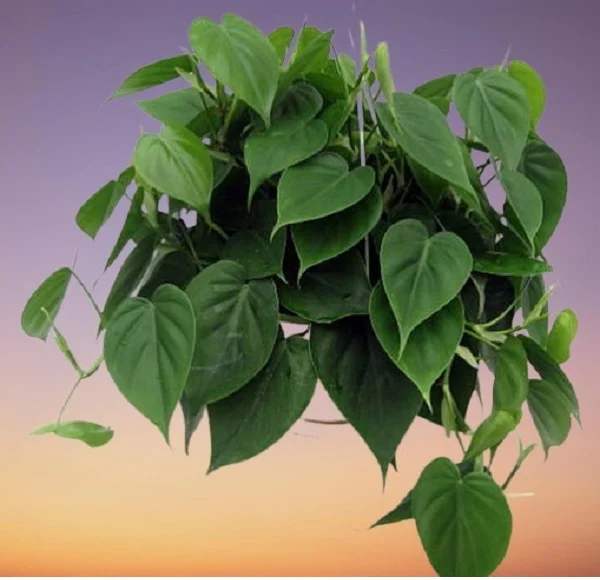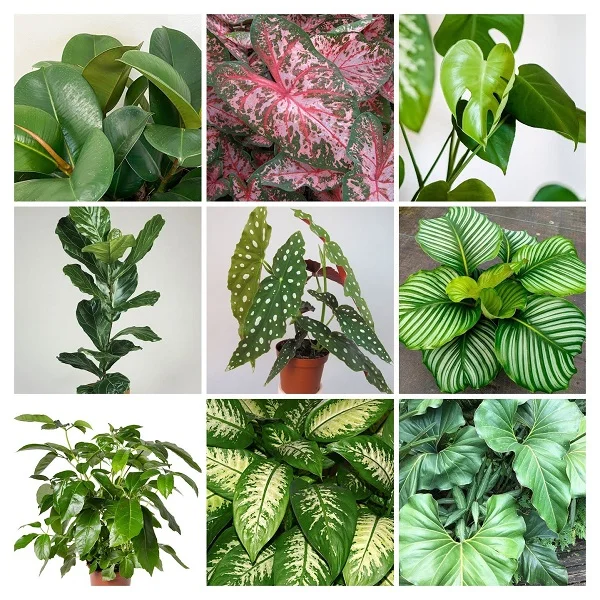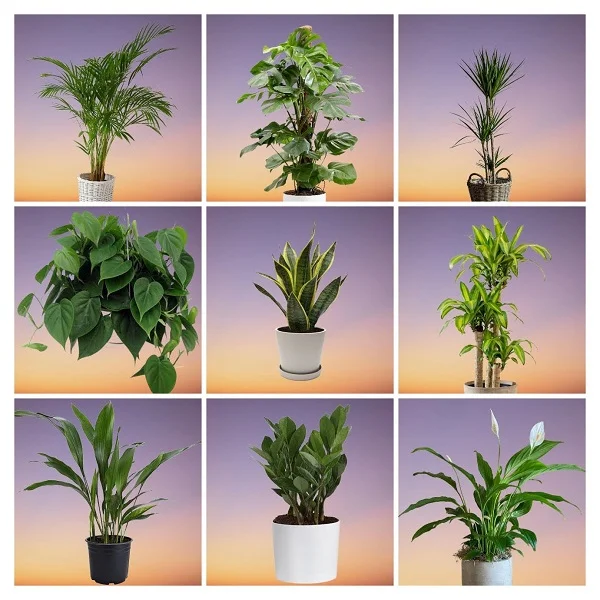How to Grow and Care for Heartleaf Philodendron (Philodendron scandens) Indoors
Some links in this post may be affiliate links
Heartleaf Philodendron (Philodendron scandens) blossoms in medium to bright indirect light, average warmth, moderate humidity and moderately moist, rich, well-drained, all purpose soils coupled with monthly feeding in the growing season.
Philodendron scandens also called Sweetheart Plant is one of the popular, fast-growing, climbing Philodendron varieties that will thrive in a wide range of growing conditions.
The heart-shaped leaves appear bronze and quickly turn green. The leaves measure about 2 inch long and cover the long slender stems.
Philodendron scandens is ideal for a hanging basket or can be grown as a climber on a trellis or moss stick. Firm support for the stems needs to be provided for the climber.
To encourage branching, pinch the growing tips otherwise Heartleaf Plant will grow with long, single stems. Always pinch after a leaf node and a new stem will grow from the node.
The Sweetheart Plant produces aerial roots from the stems and these roots have an important part to play. Push them into the soil to provide moisture for upper leaves. Flowers rarely appear under room conditions.
Based on the beauty of their heart-shaped leaves and ease of care, Heartleaf Philodendrons are some of the most popular indoor plants found in most homes.

Botanical name: Philodendron scandens
Synonym: Philodendron hederaceum
Family: Araceae
Common names: Heartleaf Philodendron, Heartleaf Plant, Sweetheart Plant
Origin
Philodendron scandens also called Philodendron hederaceum is native to the tropical forests of Central America and the Carribean where it grows as an epiphyte on trees.
Size
In its native habitat, Heartleaf Plant can grow 10-20 feet long but when grown indoors it grows to about 6 feet. The heart-shaped leaves can grow to about 1 ft long. It is among the best plants for a hanging basket.
Air Cleaning
According to the NASA Clean Air Study, Philodendron scandens was found to be one of the best air-cleaning plants which removes trichloethylene from indoor air.
On account of its trailing growth habits, spectacular foliage and air-purifying properties, Heartleaf Philodendron is one of the best plants for a study table to boost productivity.
Varieties
Heartleaf Philodendron has many varieties and cultivars, which include;
1. Philodendron hederaceum 'Micans' also called Philodendron hederaceum var hederaceum or Velvet Philodendron.
2. Philodendron hederaceum 'Brasil' which has green and yellow variegation and resembles the Brazilian flag and hence the name.
3. Philodendron hederaceum 'Cream Splash' which is thought to be a mutation of Philodendron 'Micans'.
4. Philodendron hederaceum 'Lemon Lime' has entirely yellow or pale green leaves.
5. Philodendron hederaceum 'Silver Stripe' has a silverish-cream stripe in the middle of the leaf.
6. Philodendron hederaceum 'Rio' has a silver, cream, silver, dark green variegation.
7. Philodendron hederaceum 'Gabby' has light green, cream, dark green/light green variegation and sometimes the leaf can be entirely yellow.
8. Philodendron hederaceum 'Variegata' bears leaves with pale-green or cream variegation.
Toxicity
Heartleaf Philodendron (Philodendron scandens) like other Philodendrons is toxic to both humans and pets as indicated by the American Society for the Prevention of Cruelty to Animals. The plant contains Calcium oxalate crystals.
If ingested, these crystals can cause burning and swelling in the mouth and throat, vomiting, diarrhea and abdominal pains. Therefore, keep the plant away from the reach of children and pets.
Where to Buy
If you are looking to acquire Heartleaf Philodendrons, check out these plants on Etsy (Link to Etsy).
Philodendron scandens Care Indoors
Heartleaf Philodendron (Philodendron scandens) blossoms in medium to bright indirect light, average warmth of 18-260C, moderate humidity of 50-55% and moderately moist, fertile, well-drained, all purpose potting soils coupled with monthly feeding during the growing season.
Philodendron scandens requires regular pruning to keep the plant neat, to encourage a compact, bushy growth and to rejuvenate growth. Repotting is needed every 2-3 years to provide adequate space for growth. Keep reading for a detailed account on these growing conditions and how to achieve them.

Watering
Water Heartleaf Philodendron thoroughly during the growing season while allowing the top 2-3 inches of soil to dry a little between waterings to keep the soil moderately moist.
Cut down on watering during the cold season as growth is minimal at this time but do not allow the soil to dry out completely.
Ensure that the pot has a drainage hole to avoid soggy soil as it can cause root-rot and death of the plant.
Light Requirements
Heartleaf Philodendron grows best in medium to bright indirect light. Keep it away from direct sunlight as it can cause scorching of the leaves. It will adapt to lower light conditions but it will grow more slowly in these conditions.
Philodendron scandens will also grow under a grow light where the natural light is inadequate. Check out these full spectrum grow lights available on Amazon.
Regularly rotate the pot to ensure that the plant receives light on all sides for uniform growth and to prevent leggy growth.
Temperature and Humidity
Heartleaf Philodendron prefers average warmth of 18-260C. Keep it away from cold drafts as they will affect growth negatively.
Philodendron scandens will do with a moderate humidity of 50-55%. However, too dry air may lead to dry leaf tips and edges. To raise humidity, surround the pot with wet moss or set the pot on a wet pebble tray or use a cool mist humidifier.
Clean the leaves occasionally by damp-wiping to get rid of dust and to discourage pest and disease infestation. Ensure that there is good air circulation to minimize fungal diseases.
Potting Medium
The best potting medium for Philodendron scandens should be rich in organic matter and free-draining to prevent it from getting soggy while providing the required nutrients. All purpose potting mixes are ideal for this plant.
Feeding
Feed your Heartleaf Philodendron every 4 weeks during the growing season with a balanced water-soluble fertilizer for lush growth. Withhold feeding in the cold season as growth is reduced at this time and feeding at this time can result in fertilizer burn and eventual death of the plant.
Repotting
Repot Heartleaf Philodendron every 2-3 years during the growing period. Use a pot which is 1 size larger than the current one.
Make sure that the pot has a drainage hole to prevent the soil from getting soggy as it can lead to rotting of the roots and death of the plant.
Philodendron scandens is perfect in a hanging basket where the the stems can cascade downwards beautifully. Take a look at these hanging planters with macrame hangers on Amazon.
Pruning
Pruning Heartleaf Philodendron is easy as it involves removal of yellow and dead leaves to maintain the plant neat and also reduce pest and disease infestations.
To encourage a bushy and compact growth, pinch off the growing tips at a node as new growth emerges from a node. The tips can be used to propagate new plants. Cutback the leggy stems at the beginning of the growing season to rejuvenate growth.
Propagation
Heartleaf Philodendron (Philodendron scandens) propagation can be done during the growing season from stem cuttings, by spreading the stems on the soil or by plant division. The stem cuttings can be rooted in soil or in water.
How to propagate Heartleaf Philodendron from stem cuttings in soil
Take a stem cutting of about 4-5 inches long from a healthy Heartleaf Philodendron by cutting the stem below a leaf node. Strip off the lower leaves.
Insert the cutting in moist, well-drained soil while ensuring at least on leaf node is below the soil.
Place the set up in a warm, well-lit place and maintain the soil moist until new growth has emerged.
Allow the new Sweetheart Plant to be well established before transplanting after which you can begin routine care.
How to propagate Heartleaf Philodendron from stem cuttings in water
Take a stem cutting of about 4-5 inches long from a healthy Heartleaf Philodendron by cutting the stem below a leaf node. Strip off the lower leaves.
Place the cutting in a jar of clean water while ensuring at least on leaf node is below the water surface.
Position the set up in a well-lit place and change the water every 5-7 days until roots have developed.
Transfer the new Heartleaf Philodendron into individula pots in moist, free-draining soil when the roots are about 4 in. long.
Maintain the soil moist until new growth has emerged on the new Heartleaf Plant cuttings.
Allow the new Heartleaf Philodendron to be well established before transfering the pots to their permanent position after which you can begin routine.
How to propagate Heartleaf Philodendron by plant division
During repotting, divide large Heartleaf Plant into several sections. Ensure each section has adequate healthy roots.
Plant the sections in individual pots in moist, free-draining soil and place the set up in a well-lit shaded place.
Maintain the soil moist until the new Philodendron scandens is well established and begin routine care.
How to propagate Heartleaf Philodendron by spreading the stems on the surface of the soil
Spread the Heartleaf stems on the soil surface while still attached to the mother plant.
The stems will root at every node that comes into contact with the soil.
Once rooted, sever the stems from the mother, dig them up and pot then in moist, free-draining soil in individual pots.
Place pots in a well-lit, warm place and maintain the soil moist until the new Philodendron scandens are well established after which you can begin routine care.

Philodendron scandens Problems
Heartleaf Philodendron (Philodendron scandens) growing problems are yellow leaves, dropping leaves, brown leaf tips and edges, rotting, weeping at edges, pests and diseases among others. Keep reading for more on these problems and how to fix them.
Pests
The common pests in Heartleaf Philodendron are scales, mealybugs and aphids. Isolate the affected plant to prevent spread to other plants and treat it with neem oil or insecticidal soap as indicated by the manufacturer.
Rotting stems
The reason for rotting stems in your Heartleaf Philodendron is the fungal stem-rot disease which is promoted by high moisture and too little warmth. You may save the plant by repotting and keeping the soil dry and warm for a period of time. Learn more on how to treat stem-rot disease in houseplants.
Yellowing leaves
Overwatering Heartleaf Philodendron is the reason for yellowing leaves if many leaves are affected and there are signs of wilting and rotting The remedy is to water the plant thoroughly during the growing season while allowing the top 2-3 inches of soil to dry a little between waterings. Read more on how to water indoor plants the right way.
If there is no wilting and rotting, underfeeding is the cause of yellowing leaves. Remedy the situation by feeding the plant every 4 weeks during the growing season with a balanced water-soluble fertilizer. Do not feed in the cold season to avoid fertilizer burn as growth is minimal. Learn how to feed houseplants.
If only lower leaves are affected and have dark spots and new leaves are dark and small, then underwatering is the cause of the yellowing leaves in Heartleaf Philodendron. Water the plant thoroughly during the growing season while allowing the top 2-3 inches of soil to dry a little between waterings but never allow the soil to dry out completely.
If leaves are pale colored and have straw-colored patches the cause of yellowing leaves in Heartleaf Philodendron is too much direct sunlight. Protect the plant or keep it away from direct sunlight.
Dropping leaves
As the lower leaves of Heartleaf Philodendron age they drop but if there is an abnormal leaf drop, the reason is sudden change of growing conditions. Avoid moving the plant to a new position before acclimatizing it gradually to prevent leaf drop.
If the leaves turn brown and dry before they drop, then too high temperature is the cause of leaf drop. Philodendron scandens prefers average warmth of 18-260C. Protect it from hot drafts from hot air vents, heat sources and others. Check out this guide on understanding temperature for houseplants.
Brown papery leaf tips and edges
There are two possible reasons for leaves with brown papery tips and edges in Heartleaf Philodendron. One possible reason is dry air. To remedy the problem, set the pot on a wet pebble tray or use a cool mist humidifier to raise humidity. Learn more on how to increase humidity for houseplants.
The second possible reason for leaves with brown papery tips and edges in Heartleaf Philodendron is that the plant may be pot-bound. Repot the plant into a pot 1 size larger. Ensure that the pot has a drainage hole to prevent the soil from getting soggy.
Leggy growth, small pale leaves
Too little light is the cause of leggy growth and small pale leaves as Heartleaf Philodendron will not thrive in deep shade. Move the plant to a more brighter spot where it will receive medium to bright indirect light or instal a grow light where natural light is not enough. Check out this guide on understanding light for houseplants.
Leaves weeping at the tips
If the soil is too wet, Heartleaf Philodendron will respond with leaves weeping at the tips. Allow the top 2-3 inches of soil to dry out between waterings and reduce frequency of watering to prevent the soil from getting too wet. In addition, ensure that the pot has a drainage hole and that the soil is free-draining to avoid getting the soil soggy (too wet soil).
You liked it? Share on social media.
Related Content
Amazon Associates Disclosure
Homeplantsguide.com is a participant in the Amazon Services LLC Associates Program, an affiliate advertising program designed to provide a means for sites to earn advertising fees by advertising and linking to amazon.com.





